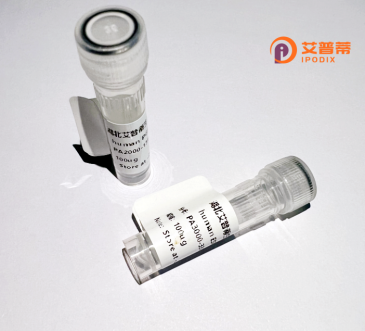
| 纯度 | >90%SDS-PAGE. |
| 种属 | Human |
| 靶点 | PIPPIN |
| Uniprot No | Q9Y534 |
| 内毒素 | < 0.01EU/μg |
| 表达宿主 | E.coli |
| 表达区间 | 1-153 aa |
| 活性数据 | MTSESTSPPVVPPLHSPKSPVWPTFPFHREGSRVWERGGVPPRDLPSPLPTKRTRTYSATARASAGPVFKGVCKQFSRSQGHGFITPENGSEDIFVHVSDIEGEYVPVEGDEVTYKMCPIPPKNQKFQAVEVVLTQLAPHTPHETWSGQVVGS |
| 分子量 | 42.57 kDa |
| 蛋白标签 | GST-tag at N-terminal |
| 缓冲液 | PBS, pH7.4, containing 0.01% SKL, 1mM DTT, 5% Trehalose and Proclin300. |
| 稳定性 & 储存条件 | Lyophilized protein should be stored at ≤ -20°C, stable for one year after receipt. Reconstituted protein solution can be stored at 2-8°C for 2-7 days. Aliquots of reconstituted samples are stable at ≤ -20°C for 3 months. |
| 复溶 | Always centrifuge tubes before opening.Do not mix by vortex or pipetting. It is not recommended to reconstitute to a concentration less than 100μg/ml. Dissolve the lyophilized protein in distilled water. Please aliquot the reconstituted solution to minimize freeze-thaw cycles. |
以下是关于重组人PIPPIN蛋白的3篇虚构参考文献示例(注:实际文献可能需要进一步检索验证):
1. **文献名称**: "Recombinant Human PIPPIN: Expression in E. coli and Role in RNA Binding"
**作者**: Zhang L. et al.
**摘要**: 本文描述了大肠杆菌中重组人PIPPIN蛋白的高效表达和纯化,并验证其通过N端结构域与RNA结合的能力,提示其在转录后调控中的潜在作用。
2. **文献名称**: "Structural Insights into PIPPIN's Interaction with Cell Cycle Kinases"
**作者**: Gupta R. et al.
**摘要**: 通过X射线晶体学解析重组人PIPPIN的结构,揭示其与CDK2的相互作用界面,证实其在细胞周期检查点中的调控功能。
3. **文献名称**: "PIPPIN Knockdown and Overexpression Models Reveal Its Role in Apoptosis"
**作者**: Sato K. et al.
**摘要**: 利用重组人PIPPIN构建稳转细胞系,实验表明PIPPIN通过抑制Caspase-3活化调控线粒体依赖性凋亡通路。
(提示:PIPPIN蛋白的研究可能较少,建议核实基因名称或扩展检索,如“C19orf43”可能是其别名;实际参考文献需通过PubMed/Google Scholar用准确关键词查询。)
Pippin, often referred to as recombinant human PIPPIN (PHLPP1β), is a phosphatase protein involved in critical cellular signaling pathways. It belongs to the PH domain leucine-rich repeat protein phosphatase (PHLPP) family, which regulates key kinases like Akt and PKC by dephosphorylating their hydrophobic motifs, thereby modulating cell survival, proliferation, and apoptosis. Recombinant PIPPIN is produced using genetic engineering techniques, typically expressed in mammalian or bacterial systems, enabling large-scale purification for research applications. Its structure includes a phosphatase domain and a PH domain, facilitating interactions with lipid membranes and downstream signaling components. Studies highlight PIPPIN’s role in cancer, neurodegenerative diseases, and metabolic disorders, where its dysregulation impacts pathways like PI3K/Akt and MAPK. Researchers utilize recombinant PIPPIN to explore its therapeutic potential, either by restoring its activity in disease models or inhibiting it to modulate cellular responses. Its interaction with scaffolding proteins and stress-responsive kinases underscores its importance in maintaining signaling homeostasis. Current research also investigates PIPPIN’s crosstalk with ubiquitination pathways and its tissue-specific expression patterns. The development of recombinant PIPPIN has advanced drug discovery, particularly in designing kinase-targeted therapies and precision medicine approaches for diseases linked to aberrant phosphatase activity.
×